Physical Address
304 North Cardinal St.
Dorchester Center, MA 02124
Congenital and neonatal abnormalities of the colon can be divided into those that present in the neonatal period, such as colonic atresia and stenosis, imperforate anus, and functional colonic abnormalities, such as small left colon syndrome and meconium plug. Entities such as Hirschsprung disease, anorectal stenosis, duplication cysts, and chronic intestinal pseudoobstruction (CIPO) are congenital abnormalities that can or even typically present later in life, while acquired entities, such as necrotizing enterocolitis, routinely affect the newborn, particularly the premature.
The colon is the least involved segment in intestinal atresias, with colonic atresia comprising between 1.8% and 15% of intestinal atresias, with an overall incidence of 1 in 1498 to 1 in 66,000 births. The anatomic descriptive classification of intestinal atresias (as described in Chapter 102 , Fig. 102.28 ) is applied to colonic atresias: type I membranous; type II blind ends separated by fibrous cord; type III mesenteric defect; and type IV multiple atresias. Atresia involves the right colon in approximately half the cases, particularly type III lesions.
Colonic atresia is associated with other colonic abnormalities, as well as extracolonic and extraintestinal comorbidities in as many as 47% of cases. Approximately 22% of patients may have Hirschsprung disease or hypoganglionosis ; other associations include malrotation, abdominal wall defect, and other atresias. Extraintestinal anomalies include the musculoskeletal system, heart, abdominal wall, eyes, and central nervous system (CNS).
Congenital colonic stenosis is very rare, with less than 20 cases reported in the literature, typically consisting of stricture-like stenosis, although membranous stenosis has also been reported. Most cases of colonic stenosis in infants are acquired, particularly as sequela of conditions such as necrotizing enterocolitis.
Similar to small bowel atresias, colonic atresias are thought to result from an ischemic event in utero leading to resorption of the involved bowel and discontinuity of the proximal and distal segments. More recently, mutations in fibroblast growth factor 10 (FGF10) or its receptor have resulted in intestinal atresia in mice, even in the absence of vascular insult, suggesting that this genetic determinant may also play a role in the intrauterine development of intestinal atresias. Most isolated cases are sporadic, but syndromic cases share a genetic basis. Hereditary multiple intestinal atresias, which include immune deficiencies and carries a very high mortality, is believed to be an autosomal recessive lesion, with mutations in the TTC7A gene.
Polyhydramnios is uncommon, because the atresia is sufficiently distal to allow resorption of swallowed amniotic fluid. Infants with colonic atresia present with abdominal distension, vomiting, and failure to pass meconium. Because the obstruction is distal, the onset of vomiting may be delayed in comparison to more proximal atresias.
Abdominal radiographs in patients with colonic atresia often show that the proximal colon is dilated far more than the other loops of bowel ( Figs. 105.1A and B ), and air-fluid levels and absence of gas in the rectum will be seen on prone cross-table lateral views ( Fig. 105.1C ). The disproportionate dilatation of the proximal colon is due to competence of the ileocecal valve, which allows intestinal contents forward into the atretic proximal colonic segment but does not allow decompression proximally. This finding is characteristic and highly suggestive of the diagnosis on plain films, although not always present. Contrast enema demonstrates a blind-ending microcolon, devoid of the filling defects that characterize meconium ileus ( Fig. 105.1D ).
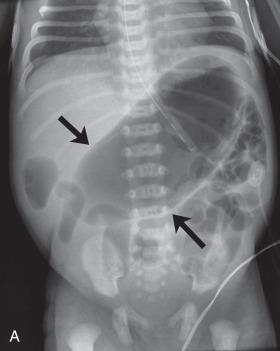
Surgery is required. Because 15% to 20% of patients with colonic atresia will also have proximal intestinal atresia, the proximal bowel should be evaluated. Hirschsprung disease should be excluded before reestablishing intestinal continuity, and existing extraintestinal anomalies should be identified. The size discrepancy between the markedly dilated proximal segment and the distal microcolon may necessitate resection of the dilated proximal segment.
Anorectal malformations (ARM) encompass the spectrum of anal atresia and stenosis, with an incidence estimated at approximately 1 : 5000 live births worldwide. Approximately one-third of patients have isolated lesions, whereas two-thirds are affected by other abnormalities in multiple organ systems as well as other portions of the gastrointestinal (GI) tract. Approximately 95% of the patients have a fistula to the urethra (males), vagina (females), or the perineum; however, among patients with Down syndrome and ARM, approximately 95% have no fistula.
ARM lesions were classified in 1953 by Gross as high and low, with respect to position of the atresia above or below the levator mechanism. Two decades later, the concept of intermediate or translevator lesions was introduced to denote the more continuous spectrum of these lesions ( Fig. 105.2 ). More recently Levitt and Peña have introduced a gender-inclusive classification that has prognostic implications as well as implications regarding optimal surgical management and outcome. Under this framework, females with high lesions (high rectovaginal fistula) who later present with a persistent/unrepaired urogenital sinus abnormality represent girls with persistent cloaca, initially confused with high anal atresia; these are classified by the length of the persistent cloacal canal ( Table 105.1 ).
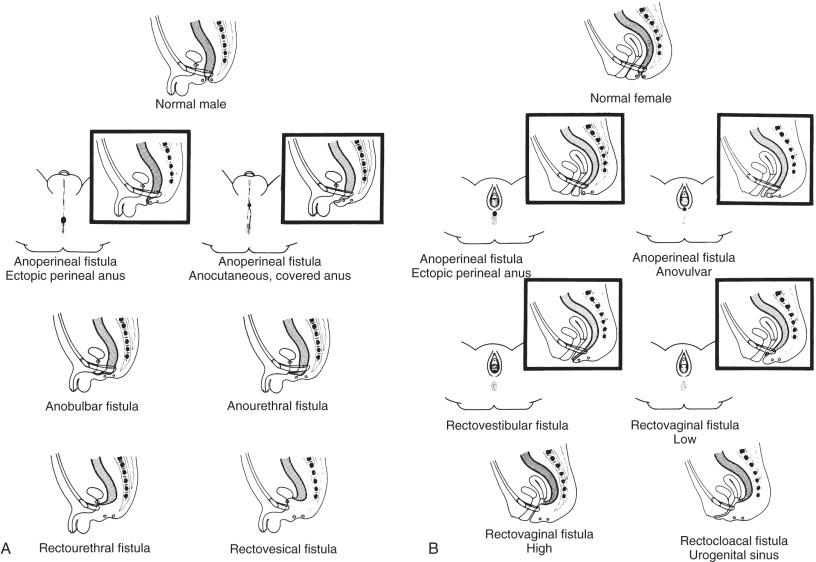
| Males | Females |
|---|---|
| Perineal fistula | Perineal fistula |
| Rectourethral fistula | Vestibular fistula |
| Bulbar | Persistent cloaca |
| Prostatic | ≤3 cm common channel |
| Rectobladder neck fistula | >3 cm common channel |
| Imperforate anus without fistula | Imperforate anus without fistula |
| Rectal atresia | Rectal atresia |
| Complex defects | Complex defects |
Rectal atresia and stenosis are discussed among the ARM lesions, although such patients have a normal anal canal and external physical findings. These lesions constitute approximately 1% of ARM lesions. In patients with rectal atresia, the rectum is atretic 1 to 2 cm above the anus.
Anorectal atresia with rectourethral or rectovaginal fistulas may be the result of failure of the urorectal septum to descend to the cloacal membrane and the eventual site of the perineal body; if the cloaca is too small, the hindgut may then terminate anteriorly, entering either the urethra in the male or the vagina in the female. Rectoanal atresias are thought to be related to vascular accidents similar to those that occur in atresias of the small bowel and colon; imperforate anus is due to failure of breakdown of the anal membrane.
No single genetic abnormality has been identified in association with ARM, but a genetic susceptibility is considered likely in many cases due to the increased risk in affected families, knock-out mice models, and the association of ARM with conditions that are part of chromosomal anomalies ; the most common chromosomal abnormalities are trisomy 21 and a microdeletion at chromosome 22q11.2, although abnormalities have been identified in multiple chromosomes. Approximately 15% of patients with rectovestibular or rectoperineal fistulas indicative of low lesions have a positive family history for ARM. Genetic studies in both animals and humans have implicated defects in the sonic hedgehog, Wnt5a, and Skt genes. These studies suggest that the pathogenetic mechanisms of high and low fistulas differ and that it may be a genetic mutation, rather than obstruction, that leads to fistula formation in some cases.
Patients with ARM are clinically apparent by physical examination at birth, with the exception of patients with rectal atresia or stenosis, who are externally normal. The physical examination may reveal a perineal or vestibular fistula, although in both genders this is best evaluated after 24 hours, as meconium may not appear in the perineum before this time. The presence of a rectourethral fistula may be revealed by identification of fecal material in the urine. Patients who demonstrate a “flat bottom” (i.e., the buttock crease is not visible) have poor development of pelvic musculature, which typically implies a more guarded prognosis. Girls with a single perineal orifice have a cloacal malformation.
Other congenital anomalies are seen in greater than 50% of patients with ARM. The best known group of anomalies associated with ARM is the VACTERL association, which includes v ertebral anomalies, a nal atresia, c ardiac abnormalities, esophageal atresia with or without te fistula, r enal and l imb abnormalities. Esophageal atresia complex is seen in approximately 10% of patients, and abnormalities affecting the duodenum, such as atresia or malrotation, are seen in 1% to 2%. Vertebral anomalies occur in approximately one-third of patients ( Figs. 105.3A and B ), and their severity may be correlated with the complexity of the anorectal lesion. Coronal clefts in particular are often seen in patients with imperforate anus and have been reported as being nine times more common in boys than in girls. Genetic syndromes include trisomy 21, trisomy 8, and fragile X syndrome. Cardiovascular abnormalities are seen in about one-third of patients and most commonly consist of atrial septal defect and persistent ductus arteriosus, followed by tetralogy of Fallot and ventricular septal defect. Hirschsprung disease is rare, being seen in only 3 out of 2100 patients. Genitourinary anomalies are common, presenting in one-third to one-half of cases, again correlated with increasing complexity of the defect. These range from reflux to renal dysplasia or agenesis, with cryptorchidism and hypospadias seen in male patients. Females may demonstrate Müllerian abnormalities, including duplications and obstructions, particularly in the setting of cloacal abnormalities.
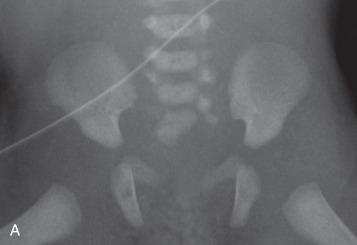
Patients with ARM undergo imaging to elucidate associated anomalies and to determine the fistulous anatomy. The sacral ratio quantifies the degree of sacral hypoplasia by measuring the distance between the iliac crests and the inferior border of the sacroiliac joints (A–B) and the distance between the inferior border of the sacroiliac joints and the tip of the sacrum (B–C); the BC/CD ratio should be greater than 0.4. Increase in the ratio to approach 1.0 indicates better sacral development and better potential prognosis.
Imaging of these infants usually includes cardiac evaluation, radiographs of the spine, ultrasound of the kidneys and of the spinal canal, as well as ultrasound of the pelvis in girls, particularly those with cloacal anomaly, as uterine anomalies often exist. Perineal scanning is an important supplement to the imaging of these patients.
In patients who do not have a perineal fistula, several imaging methods have been used for evaluation of the distal anatomy. One of the earliest methods, still in use by some, is the lateral invertogram, or more recently the prone cross-table lateral view of the rectum, which relies on visualizing the gas-filled rectum and relating its termination to pelvic bony landmarks, particularly extension below the coccyx, which would classify it as part of a low lesion. However, problems such as meconium distal to gas, and movement of the rectum with infant straining and crying ( Fig. 105.4A ), render this examination often inexact and problematic, and it has been abandoned by many. Some investigators advocate performing a voiding cystourethrogram (VCUG) during initial evaluation, as it may reveal the fistulous connection (see Fig. 105.4A ). This procedure is not always successful because voiding pressure at the urethra may be insufficient to overcome blockage of meconium in the fistula.
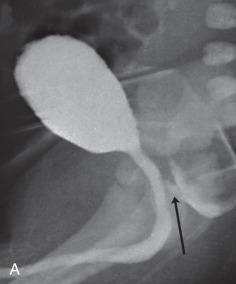
Ultrasound is also used to evaluate the distal position of the rectum ( Fig. 105.4B ). The meconium in the pouch allows easy visualization of the distal rectum; however, changes in apparent position with straining make it somewhat challenging; measurements of 10±4 mm correlate with a low lesion, whereas measurements of 24±6 mm correlate with intermediate and high lesions. Other authors use 15 mm as the differentiator of low verus intermediate and high lesions. Transverse rather than sagittal transperineal scanning can identify the puborectalis musculature; the presence of this musculature correlated with low-type lesions, whereas its absence correlated with high-type lesions.
In patients without a perineal fistula who are initially managed with colostomy, evaluation after colostomy can be done through a colostogram, considered by many to be one of the most important anatomic imaging studies, outlining the presence and location of the fistula, the bowel that will be used in the pull-through procedure, and the bony pelvic anatomy ( e-Figs. 105.5A and B ). The examination is performed under fluoroscopic control, and once the distal rectal vault has reached a rounded appearance, the examination should be considered complete.
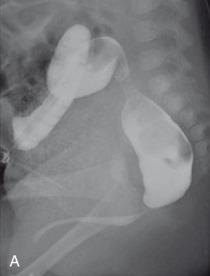
Magnetic resonance imaging (MRI) has also been used to identify the internal anatomy. High field strengths, small field of view, and sequences without fat suppression increase the conspicuity of the muscles of the pelvic floor and help visualize the position of the distal rectal pouch with respect to the levator mechanism. Instillation of gadolinium can facilitate delineation of the anatomy. Magnetic resonance (MR) can also delineate Müllerian anomalies associated with cloacal malformation in girls with ARM. Three-dimensional (3D) reformats offer additional global information for the surgeon ( e-Figs. 105.5C and D ). MR is superior to colostogram in its ability to delineate the musculature of the pelvic floor, the levator group including the pubococcygeus, puborectalis, and iliococcygeus muscles, as well as the external anal sphincter (EAS). This modality can also be used to evaluate the rectum and levator sling after definitive surgical repair ( Figs. 105.6A and B ).
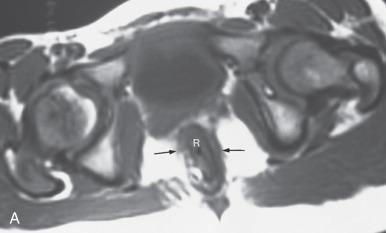
Patients with rectal atresia who have normal-appearing external anal apparatus are imaged in the same manner as patients presenting with distal obstruction, by performing a contrast enema. The enema is diagnostic in that it demonstrates a very short distal rectum that terminates blindly ( e-Fig. 105.7 ).
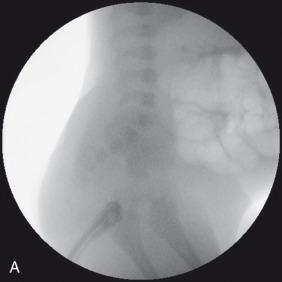
The treatment is surgical but varies with the level and complexity of the lesions. Most boys can be repaired with a posterior sagittal approach alone, although some with a high lesion will require an additional abdominal surgical component to mobilize a very high rectum. In girls, operative repair of the cloacal anomaly can be extremely challenging when there is a long channel. Babies with rectal atresia typically undergo initial colostomy, with subsequent anastomotic repair of the atretic rectum with the anal canal.
This entity was initially described in 1981 as a triad of anorectal stenosis or other type of low anorectal malformation: anterior sacral defect such as scimitar, crescent or sickle deformity, and a presacral mass such as meningocele, teratoma, or enteric cyst. Since that time, our understanding of this abnormality has undergone an evolution, with recognition of a much wider spectrum of phenotypic abnormalities and of an underlying genetic defect.
Currarino syndrome is an autosomal dominant disorder with variable penetrance; approximately 50% of the cases are sporadic. A mutation located at 7q36 encoding for the HLXB9 ( MNX1 ) gene that encodes for nuclear transcription factor HB9, which plays a role in the dorsoventral separation of the caudal embryo. Other genes related to the same differentiation pathway may be involved in cases that are negative for HLXB9 mutations. A phenotype has been described that includes abnormal facies and development, associated with a normal MNX1 gene and a larger distal 7q deletion.
Age at presentation is a spectrum that spans the fetal and adult age groups. A fetus may present with a presacral mass, a neonate with anal atresia, and an older child and adult with constipation, meningitis, or presacral malignancy. The spectrum of presacral masses includes teratoma, rectal duplication cyst, anterior meningocele, leiomyosarcoma, and ectopic nephroblastoma.
Other features of the full spectrum of the syndrome include Hirschsprung disease, dysganglionosis, bladder motility abnormalities, vesicoureteral reflux, rib anomalies, urinary and gynecologic abnormalities, cord tethering, and intraspinal lipomas.
Radiographs of the sacrum may reveal the typical scimitar-shaped sacral abnormality ( Fig. 105.8A ); however, other sacral defects, typically deletion abnormalities, may be present. In a minority of patients, the sacrum is normal.

Patients with anorectal stenosis may have a rectoperineal fistula or an anteriorly placed anus, and present with constipation, sometimes in early adulthood. Contrast enema shows marked narrowing of distal rectum, with excessive stool proximally ( Fig. 105.8B ). If of sufficient size, the presacral mass will exert a visible mass effect upon the posterior wall of the distal rectum.
MRI demonstrates the presacral mass and images the spinal canal well ( Fig. 105.8C ). In young infants, the presacral mass is often visible sonographically ( Fig. 105.8D ).
Become a Clinical Tree membership for Full access and enjoy Unlimited articles
If you are a member. Log in here